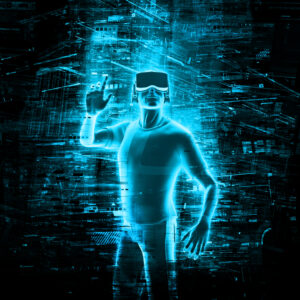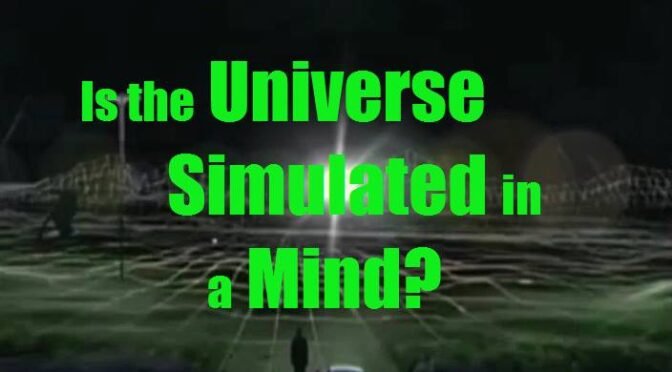A new physics documentary was recently released entitled Digital Physics Meets Idealism: The Mental Universe, explaining how the universe is actually a virtual reality simulated in a cosmic mind.
As hard as this may be to believe, recent evidence such as the falsification of realism by physicist Anton Zeilinger in 20071 as well as other discoveries in quantum gravity revealing spacetime to emerge from quantum information, suggest physical reality is a Matrix-like simulation. However, a simulation in a mind?
What do virtual realities, quantum gravity, digital physics and cognitive science tell us about the universe? Find out in this fascinating documentary, Digital Physics Meets Idealism: The Mental Universe.
According to Integrated Information Theory, or IIT, the foremost theory in cognitive science, consciousness is integrated information. What this means is that the bits of information in a conscious state can not be dissociated from one another. For example the information describing the round shape of a rose can not be separated from its red color. One can not have redness by itself without the round shape nor the round shape without a color to fill it in.
 In consciousness studies there are numerous theories regarding what consciousness really is and no one can agree. What motivated IIT, though, was a realization that despite this widespread disagreement the one thing that is agreed upon by everyone is what the subjective experience we call consciousness is like.
In consciousness studies there are numerous theories regarding what consciousness really is and no one can agree. What motivated IIT, though, was a realization that despite this widespread disagreement the one thing that is agreed upon by everyone is what the subjective experience we call consciousness is like.
When we look at something we are seeing and/or thinking of bits of information integrated together, be they perceptions or ideas, such that they can not be separated like in the example above.
The neat thing about this is that this works regardless of one’s metaphysical outlook or belief about the mind. We all perceive consciousness as integrated information whether we are functionalists, emergentists, dualists, materialists, idealists, type-type identity theorists, AI theorists, panpsychists, neutral monists or etc. In other words IIT offers a way to redefine the problem so as to give it a firm foundation that everyone can agree upon and build from.
Your conscious perception of this image of the rose provides a simple illustration of integrated
information. The red color and round shape are part of a unified whole and can not be reduced.
Integrated Information Theory describes this redness and roundness with a single integrated phi state.

What is interesting though is that information is ubiquitous and can be found anywhere. It need not be information in a brain for example. It can also be information in a computer or in anything else, and it can even be the quantum information found in quantum entanglement.
In fact Giulio Tononi the cognitive scientist behind IIT explicitly identifies entangled quantum information as a form of integrated information2. In Consciousness as Integrated Information: A Provisional Manifesto he writes:
”Quantum entanglement and integrated information, to the extent that one cannot perturb two elements independently, they are informationally one.”
Whether or not human consciousness is tied to entanglement is a matter of controversy, though some have reported links between entanglement and consciousness in the mechanism responsible for shutting off consciousness in anesthesia.
However, it is important to note that even among those who reject such a view, the predominant alternative is functionalism, the belief that the mind is a function of brain activity. Interestingly though, on functionalism entangled information would be identical with consciousness anyway as it functions as integrated information in a mathematically precise way! If consciousness is a function, then it need not matter what is doing the function. But how does this tie into what is simulating the universe?
Sean Carroll, one of the brilliant physicists behind the AdS/MERA correspondence. When Professor Carroll’s theory is combined with IIT it shows the universe to be an emergent Matrix-like simulation of entangled quantum information in a cosmic mind.
Meet Sean Carroll, a physicist from the California Institute of Technology. By working on the quantum gravity problem, the attempt to merge quantum mechanics with Einstein’s relativity, scientists found a relationship between gravity and entanglement. By taking this relationship further, Carroll believes that spacetime is actually simulated from entangled quantum information3 at a deeper layer of reality.
 As explained in The Mental Universe, Carroll’s theory called the AdS/MERA correspondence, short for the mouthful “Anti-deSitter/Multiscale Entanglement Renormalization Ansatz,” correlates patterns of entangled information with the spacetime geometries that emerge from them.
As explained in The Mental Universe, Carroll’s theory called the AdS/MERA correspondence, short for the mouthful “Anti-deSitter/Multiscale Entanglement Renormalization Ansatz,” correlates patterns of entangled information with the spacetime geometries that emerge from them.
The documentary then shows a clever way this can already be proven from direct deductions from known quantum experiments, confirming Professor Carroll’s theory. Put AdS/MERA and IIT together though and it turns out that this entangled information is actually consciousness! Spacetime and all of the objects in it emerge from underlying consciousness!
IIT, however, excludes information not in one’s conscious state, so not all of this consciousness, or phi as Tononi calls it, is ours. This would also make it seem that the universe is not simulated in one mind either.
Though, as it turns out, entanglement, and therefore also information integration, is relative to one’s reference frame in quantum mechanics. If a high enough reference frame exists, which would be described by some universal wavefunction, then that frame would encode the phi of a single cosmic mind, and the entire universe would be simulated inside it!
As it turns out, the existence of such a universal wavefunction was recently confirmed by a very interesting experiment4. Meaning the universe is in fact simulated in a cosmic mind! However, I will leave that, and much more, for you to discover in the documentary above.
By: Steve Jordan
References:
1. Zeilinger, Anton et al (2007) An Experimental Test of Non-Local Realism, Nature
2. Tononi, Giulio (2008), Consciousness as Integrated Information: a Provisional Manifesto, Footnote 14
3. Carroll, Sean (2015) Does Spacetime Emerge From Quantum Information?, The Preposterous Universe Blog
4. Moreva, Etkaterina et al (2013) Time from quantum entanglement: an experimental illustration

